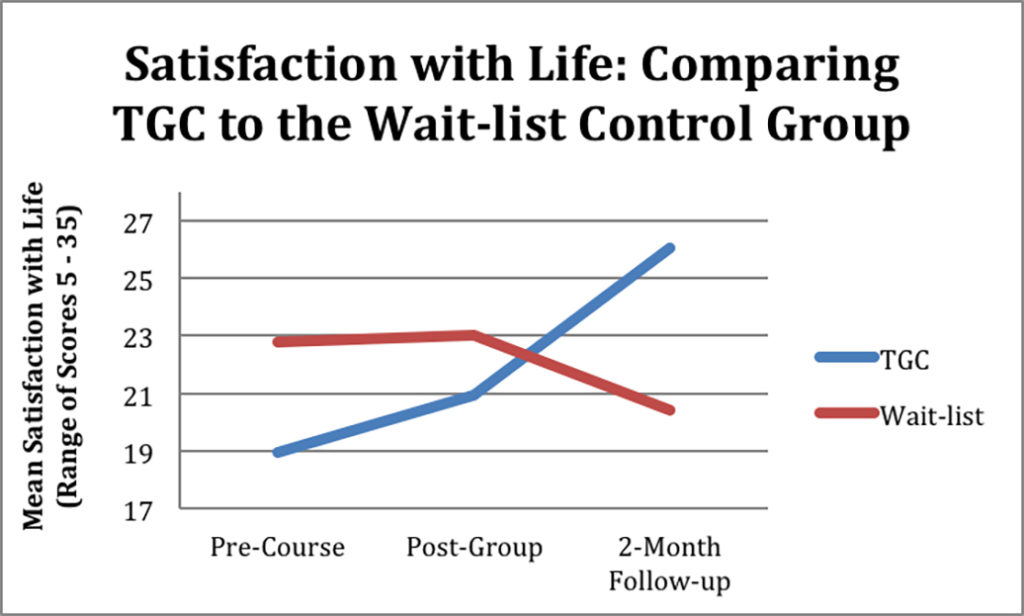Overview
The Positive Neuroplasticity Training – six, 3-hour classes combining presentations, experiential activities, and written materials – teaches participants how to turn passing experiences into lasting inner strengths. This training (previously titled the Taking in the Good Course) was evaluated in a peer-reviewed published study: Learning to Learn from Positive Experiences. Key findings included significantly less anxiety and depression, and significantly greater self-control, savoring, compassion, love, contentment, joy, gratitude, self-esteem, self-compassion, satisfaction with life, and overall happiness.
Introduction
Resilience, positive emotions, compassion, gratitude, and other inner strengths lower stress, grow well-being and effectiveness, and heal anxiety and depression. Like any other mental capability, inner strengths are supported by structures in the brain. So, how can a person develop the neural networks that support inner strengths?
Through what’s called “experience-dependent neuroplasticity,” the main way to develop inner strengths is to have experiences of them; repeated feelings of gratitude make a person more grateful. As neuroscientists might say, positive neural traits are built from positive mental states.
But here’s the problem: the brain is bad at learning from good experiences but good at learning from bad ones. In a scientific paper famously titled Bad Is Stronger Than Good, Roy Baumeister and colleagues listed many ways that the human brain has a “negativity bias.” We continually look for negative information, over-react to it, and then quickly store these reactions in brain structure. For example, we learn faster from pain than from pleasure, and negative interactions have more impact on a relationship than positive ones. In effect, our brain is like Velcro for the bad but Teflon for the good. (See Further Reading below for more information.)
This suggests that many of the positive experiences we have in everyday life or in formal trainings are not converted into neural structure: they feel good in the moment but have little lasting value. This negativity bias kept our ancestors alive in tough conditions, but now it’s a “bug” in the Stone Age brain in the 21st century: a bottleneck that blocks good experiences from becoming inner strengths built into neural structure.
Positive Neuroplasticity Training
To address this problem, Dr. Rick Hanson developed the Positive Neuroplasticity Training (PNT): six 3-hour classes that combine experiential exercises, presentations, discussion, home practice, and readings. Participants learn how to turn passing experiences into lasting inner strengths through the four step HEAL process: Have a positive experience, Enrich it, Absorb it, and (optional) Link the positive experience to negative material in order to soothe and even replace it. They apply these skills to positive experiences in everyday life, using one or two dozen seconds to take in a moment of relaxation, a sense of accomplishment in finishing a task, or the warmth in a friend’s smile.
During the course, participants “take in the good” (TG) to develop greater overall well-being, as well as to internalize the key resource experiences that address personal issues of stress, anxiety, irritation, frustration, loss, blue mood, loneliness, hurt, or inadequacy. The course aims at three kinds of benefits: (1) growing specific inner strengths; (2) developing the qualities implicit in TG (e.g., kindness toward oneself), and (3) increasingly sensitizing the brain to positive experiences.
Research Findings on the Course
In a pilot study, a battery of psychological tests was administered before and after the course the first two times it was offered (see List of Tests below.) After taking the course, people reported significantly:
• Less anxiety and depression
• More savoring and enjoyment of life, and more gratitude
• Greater mindfulness and better self-control
• More love and self-compassion, and higher self-esteem
• More positive emotions and fewer negative ones
• Greater overall happiness and satisfaction with life
Then, in a formal study, we systematically evaluated the effects of the Positive Neuroplasticity Training by randomly assigning participants either to the course in the spring of 2013 or to a wait-list to take the course in the summer of 2013. Those who completed the spring course reported greater contentment, gratitude, self-esteem, savoring, and satisfaction with life compared to those who had not yet taken the course. Further, two months following course completion, participants reported greater use of reappraisal strategies to help regulate their emotions and they continued to experience greater self-esteem compared to those who had not yet taken the course (please see the graph just below).

People on the wait-list then took the course in the summer of 2013. In the next step in our analyses, we combined participants from the spring and summer groups, and then compared their scores on the battery of tests before and after completing the course. (We also assessed the stress hormone, cortisol, but found no significant results.) Consistent with the results of the pilot study, after taking the course, people reported significantly:
• Less anxiety and depression
• More able to manage emotions
• More joy, contentment, and other positive emotions
• More love and compassion
• More gratitude
• More self-compassion
• More savoring
• Greater overall happiness
Conclusion
It is possible to teach people how to make good stronger than bad.
Acknowledgements
The investigators in this study included Rick Hanson, Ph.D. (The Wellspring Institute for Neuroscience and Contemplative Wisdom), Janelle M. Caponigro, M.A. (UC Berkeley), Michael R. Hagerty, Ph.D. (UC Davis), and Ann Kring, Ph.D. (UC Berkeley).
Financial support was provided by the Wellspring Institute for Neuroscience and Contemplative Wisdom.
Further Reading
Baumeister, R. F., Bratslavsky, E., Finkenauer, C., & Vohs, K., D. (2001). Bad is stronger than good. Review of General Psychology, 5(4), 323-370. doi: 10.1037//1089-2680.5.4.323
Rozin, P., & Royzman, E. B. (2001). Negativity bias, negativity dominance, and contagion. Personality and Social Psychological Review, 5(4), 296-320.
Hanson, R. (2013). Hardwiring Happiness: The New Brain Science of Contentment, Calm, and Confidence. New York: Random House.
(2021), Learning to learn from positive experiences, The Journal of Positive Psychology, DOI: 10.1080/17439760.2021.2006759
Supporting Handouts
Lists of Tests
Pilot Study
Positive and Negative Affect Schedule (PANAS; Watson, 1988)
Savoring Beliefs Inventory (SBI; Bryant, 2003)
Mindfulness and Attention Scale (MAAS; Brown & Ryan, 2003)
Self-Compassion Scale – Short (SCS; Raes, 2011)
Emotion Regulation Questionnaire (ERQ; Gross, & John, 2003)
Gratitude Questionnaire (GQ-6; McCullough et al., 2002)
Rosenberg Self-Esteem Scale (RSES; Rosenberg, 1965)
Personal Growth Initiative Scale (PGIS; Robitscheck, 2009)
Satisfaction With Life Scale (Diener, 1985)
NEO Five-Factor Inventory – Openness Subscale (Costa & McCrae, 1989)
Positive Rumination Scale (Feldman et al., 2008)
Event Reaction Questionnaire (Higgins et al., 2001)
Dispositional Positive Emotion Scales (Shiota et al., 2006)
Psychological Well-Being Scales, select subscales (Ryff, 1998)
Subject Happiness Scale (Lyubomirsky, 1999)
Beck Anxiety Inventory (1993)
Beck Depression Inventory (Beck, 1996)
Formal Study
Positive and Negative Affect Schedule (PANAS; Watson, 1988)
Savoring Beliefs Inventory (SBI; Bryant, 2003)
Mindfulness and Attention Scale (MAAS; Brown & Ryan, 2003)
Self-Compassion Scale – Short (SCS; Raes, 2011)
Emotion Regulation Questionnaire (ERQ; Gross, & John, 2003)
Gratitude Questionnaire (GQ-6; McCullough et al., 2002)
Rosenberg Self-Esteem Scale (RSES; Rosenberg, 1965)
Satisfaction With Life Scale (Diener, 1985)
Positive Rumination Scale (Feldman et al., 2008)
Dispositional Positive Emotion Scales (Shiota et al., 2006)
Subject Happiness Scale (Lyubomirsky, 1999)
Beck Anxiety Inventory (1993)
Beck Depression Inventory (Beck, 1996)
Salivary cortisol was assessed through Genova Diagnostics.




